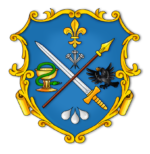Biography

Saint Benedict of Nursia was the founder, Patriarch, and first Abbot of the great order of the Benedictines. He was of noble birth, and a native of Norcia, in the duchy of Spoleto. He studied at Rome, but soon wearied of the ‘profligacy’ (superfluous ornament) of those about him; and imbibing the ideas of Saint Jerome and Saint Augustine in favor of solitude, at fifteen he became a hermit. His nurse, who loved him dearly, followed him to his retirement, and ministered as much as possible to his comfort. But he, regarding this as a drawback to perfect holiness, fled from her to Subiaco, a wilderness forty miles from Rome.
Here he lived for three years, entirely unknown, except to Romano, another hermit, who shared with him his bread and water. Here he was greatly tempted by the recollections of the world he had left, and especially, at one time, by the remembrance of a beautiful woman he had seen at Rome, when, to overcome his great desire to return to her, he flung himself into a thicket of briers and thorns, and rolled himself in them until his skin was lacerated and bleeding. The monastery in Subiaco shows roses, said to have been propagated from these briars.
The fame of his sanctity at last brought great crowds to him, who begged his prayers, and that he would heal their diseases; and a company of hermits nearby requested that he would be their head. But when they saw the severity of his life, they attempted to poison him. When he made the sign of the cross before the poisoned cup, it fell to the ground in fragments. He then returned to his cave and again dwelt alone. But so many hermits came to Subiaco and lived in huts and caves, that at length, for the sake of order, Benedict commanded them to build twelve monasteries, and he placed twelve monks in each.
Two senators of Rome brought to him their sons, Maurus and Placidus, to be educated as Christians. They were but twelve and five years of age, and they became the special charges of Benedict.
Satan, much troubled by all of this, put into the heart of a priest, Florentius, to traduce the character of St. Benedict, and to poison him with a loaf of bread. These plans failing, he at last brought seven young women into one of the monasteries to try the chastity of the monks. Benedict left Subiaco, and immediately Florentius was crushed to death beneath a falling gallery in his own house. Benedict even wept for his fate, and imposed penance on Maurus when he rejoiced at it.
There still remained at this time, on Monte Cassino, a temple of Apollo. There Benedict went, and by his miracles and preaching converted the idolaters, so that they broke the statue and altar, and burnt the grove. The saint then built two chapels, and dedicated them to St. John the Baptist and St. Martin of Tours. On the summit of this mountain he founded the monastery which has always been regarded as the parent of all others of the Benedictine Order. There, he promulgated the rules of his order.
His sister Scholastica followed him to Monte Cassino, and he visited her once a year during the last years of his life.
In 540 Totila, King of the Goths, visited Benedict, and entreated his blessing. The saint reproved him for his past life, and it was thought that after this the Goth was less ferocious.
Before his death, monasteries of his order were instituted in all parts of Europe. He was at last seized with fever, and on the sixth day he ordered his grave to be dug, and after standing upon the edge of it, supported by his disciples, and in silent contemplation, he was borne to the altar of the church, and receiving the last sacraments there died. March 21, A.D. 543.
Saint Benedict. Christian Symbols and Stories of the Saints By Clara Erskine Clement and Katherine E. Conway. Ticknor and Company, Boston, Massachusetts. 1886
